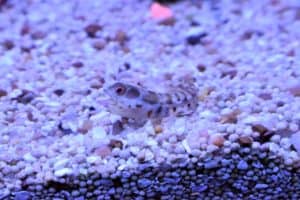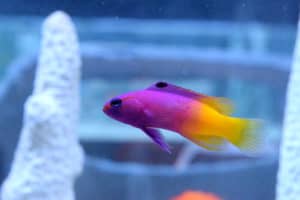5 Nano Reef Fish
By: Chris Fong
As the hobby continues to evolve with advancements in technology ever growing nano reefs are becoming more and more popular. These setups are attractive towards most people due to their small size requirements, significantly smaller setup cost compared to larger systems, and the wide variety of options aquarist can choose from in terms of equipment and livestock. However, even as our understanding of aquariums has improved along with advancements in technology small tanks in general are still considered more difficult due to their smaller volume of water. As a result, the aquarist should pay extra attention towards these smaller setups to help reduce fluctuations in parameters which could be potentially devastating.
To clarify a Nano reef is considered around 5-30 US gallons by most people and the fish described in this blog will comfortably live in this 30-gallon setup long-term considering their husbandry requirements are met. These requirements include a properly cycled aquarium with adequate filtration, heating, water quality combined with proper compatibility and diet. In this blog I will discuss 5 great fish species suited for a Nano reef.
Side Note: The best fish suited for small nano reefs or pico reefs long term are gobies as most of them stay incredibly small. But to add variety to this list I decided to add other fish that can live comfortably in a larger nano tank.
- Panamic Barnacle Blenny (Acanthemblemria hancocki)
This fish can be located from Panama to El Salvador and even as far down as Ecuador. It is an excellent choice for Nano tanks as it has a maximum size of 2 inches when fully grown. The barnacle blenny has a unique personality preferring to sit inside of a small hole and occasionally poke it’s round head out to look for food and predators. On top of this, the barnacle blenny also has large googly eyes making it an adorable addition to a small tank. Also, when food is added to the aquarium the barnacle blenny will dart out of its crevice at an incredibly fast speed and then quickly retreat into the same crevice making it a very entertaining fish to observe while feeding.
The barnacle blenny should be kept with peaceful fish although it can sometimes exhibit aggression towards similar looking fish or fish that invade its territory. Additionally, many nooks and crannies should be made available for this fish to hide in naturally. Finally, a diet of small meaty foods such as frozen blood worms, brine shrimp, plankton, and Mysis shrimp should make up most of its diet combined with quality flakes/ pellets that have been soaked in vitamins.
- Royal Gramma (Gramma loreto)
While the Royal gramma is the largest fish on this list growing to 3 inches when fully grown making it ideal for tanks around 30 gallons for long term housing I decide to include it in this list because of it’s outstanding coloration and hardiness. Naturally these fish are found in deep water reefs in the Caribbean hiding in and around rock crevices. Due to this natural behavior the royal gramma will hide a lot especially when first introduced into the aquarium. Over time though this fish will become bolder and venture out into the open.
Royal Grammas are very hardy fish making ideal for beginners who want to add a colorful fish to their larger sized Nano reef. While mostly peaceful towards other fish the royal gramma can sometimes be territorial towards other similar looking fish or fish that invade its territory. Due to its cryptic behavior a large amount of rock structure should be provided. Finally, a diet of small meaty foods such as frozen blood worms, brine shrimp, plankton, and Mysis shrimp should make up most of its diet combined with quality flakes/ pellets that have been soaked in vitamins
- Clown Goby (Gobiodon sp.)
Clown gobies are another excellent Nano reef fish as there are several species each with a distinct color. Some are green with red markings on their face while others are solid yellow or black. This group of fish only max out around 1 inch making another fine addition to small tanks where you will find them perching on rocks and corals. These small gobies are naturally found living amongst soft and hard coral colonies in the Indo Pacific where they utilize these corals for shelter. However, in the reef aquarium they can sometimes kill portions of SPS colonies they host as a result.
Clown gobies are considered very hardy and peaceful towards most other fish but can sometimes become territorial with other similar fish or those that enter its territory. Additionally, hiding places and a variety of coral should be provided for clown gobies to find shelter and establish territories. Finally, a diet of small meaty foods such as frozen blood worms, brine shrimp, plankton, and Mysis shrimp should make up most of its diet combined with quality flakes/ pellets that have been soaked in vitamins.
- Ataenia Wrasse/ Pink Streaked Wrasse (Pseudocheilinops Ataenia)
This small wrasse is better suited for Nano tanks than its close cousin the six-line wrasse (Pseudocheilinus hexataenia) because it stays slightly smaller when fully grown at around 2 inches and is less aggressive. This small reef fish can be found in the Indo Pacific darting in and out of rocks looking for small critters to feed on. Like the royal gramma this is another shy fish that will hide initially but later become bolder.
The Ataenia Wrasse does best when kept with peaceful fish in a tank with large amounts of hiding place in order to feel safe. Avoid tankmates that are overly active to as this may cause the Ataenia Wrasse to feel threated and stay in hiding. Finally, a diet of small meaty foods such as frozen blood worms, brine shrimp, plankton, and Mysis shrimp should make up most of its diet combined with quality flakes/ pellets that have been soaked in vitamins.
- Geometric Pygmy Hawk (Plectranthias sp.)
I saved the best for last as this fish means a lot to me personally. The reason being this was my first ever salt water fish and I had the pleasure of keeping it for several years. While this fish looks and acts more like a hawk fish it is more closely related to Anthias being within the sub family of Anthiine. They are naturally found in rubble zones of Cebu perching on rocks while looking out for food and predators. They also reach a max size of 2 inches when fully grown making it an excellent addition for those who want to add something different to their Nano reef.
The geometric pygmy hawk does best in tanks with large amount of rock for hiding and feeding. Unfortunately, this fish can sometimes be aggressive towards other bottom dwellers like gobies and blennies and is also capable of eating small shrimp. So, plan accordingly and have lots of rocks and caves which will help to diffuse aggression. Finally, a diet of small meaty foods such as frozen blood worms, brine shrimp, plankton, and Mysis shrimp should make up most of its diet combined with quality flakes/ pellets that have been soaked in vitamins.
Please ask these associates Glen, Todd, Eric, Greg, Kevin, Paul, Heather and myself to personally show you these fish along with other choices for your nano aquarium!




